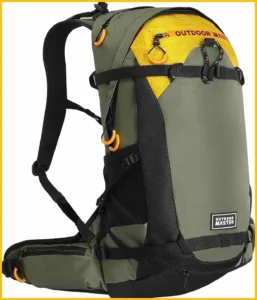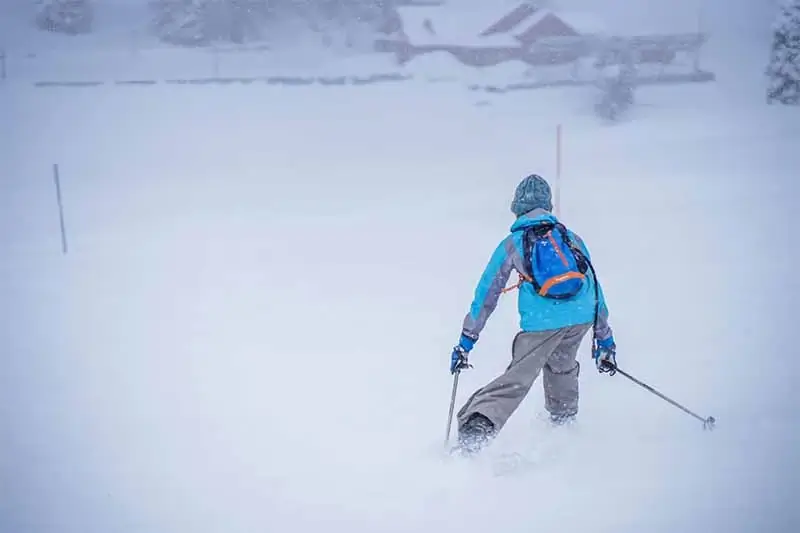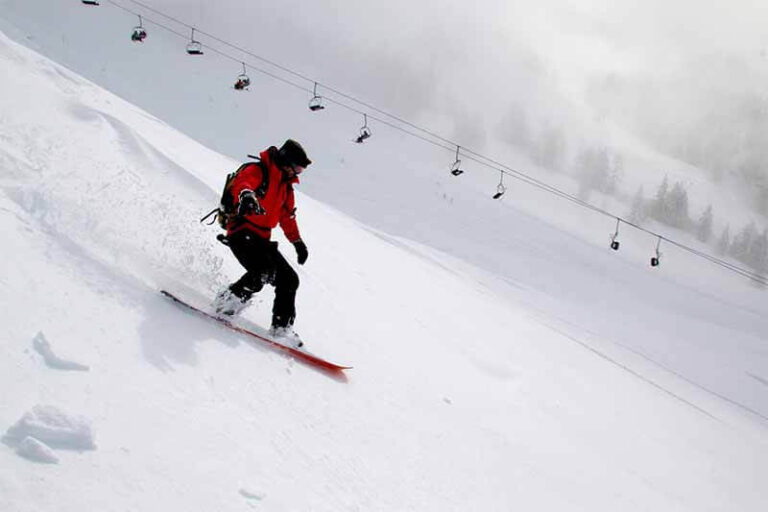5 Best Snowboard Backpacks of 2024
Snowboarding isn’t just a sport—it’s an adventure. Whether you’re carving through fresh powder, navigating challenging trails, or exploring off-piste terrains, having the right gear can significantly enhance your experience.
Among the essentials, a high-quality snowboard backpack stands out as a must-have.
A good snowboard backpack is more than just a storage bag; it’s a companion that keeps your gear organized, protected, and easily accessible.
From holding your avalanche tools and hydration pack to carrying your helmet and extra layers, the best snowboard backpacks are designed to offer unparalleled convenience.
They ensure you’re well-prepared for any situation, whether it’s a quick run down the slopes or a full day of backcountry snowboarding.
Safety is another critical factor. Many snowboarding backpacks come with innovative features like reinforced compartments for fragile equipment, secure snowboard carry systems and even avalanche safety tools.
These features not only make your journey smoother but also provide peace of mind in unpredictable mountain conditions.
Finding the best snowboard backpack can make or break your snowboarding adventure. By choosing the right backpack, you can focus on the thrill of the ride without worrying about the hassle of carrying and protecting your gear.
In this guide, we’ll explore everything you need to know to select the perfect snowboarding backpack tailored to your needs.
What is the Best Snowboard Backpack?
Here are the top picks of the best snowboard backpacks to purchase for your next snowboarding adventure.
1. Osprey Glade Snowboard Backpack

2. Burton Snowboard Backpack

3. Outdoor Master Snowboard Backpack

4. CamelBak Snowboard Backpack

5. Unigear Snowboard Backpack

What to Look for in the Best Snowboard Backpack
Choosing the right snowboard backpack is essential to ensure a comfortable, safe, and hassle-free experience on the slopes.
Not all backpacks are created equal, and when it comes to snowboarding, certain features can make a significant difference.
Here’s what to look for to find the perfect fit:
Waterproof or Weather-Resistant Materials
Snowboarding exposes your gear to extreme weather conditions, including snow, rain, and cold.
A snowboard backpack made from waterproof or weather-resistant materials ensures that your belongings, such as extra clothing, electronics, and snacks, stay dry and protected throughout your adventure.
Look for backpacks with sealed zippers and reinforced fabrics that can withstand snow and moisture.
Comfortable and Adjustable Straps
Snowboarding often involves hours of physical activity, so comfort is paramount. A well-designed snowboard backpack will have padded shoulder straps, a chest strap, and a waist belt to distribute weight evenly.
Adjustable straps also allow you to customize the fit, ensuring the backpack stays secure during high-speed runs or jumps.
Comfort-focused features like breathable back panels can also prevent excessive sweating.
Specific Compartments for Essential Gear
A good snowboard backpack is not just about storage—it’s about organization.
Look for backpacks with specialized compartments to carry gear like:
- Hydration Packs: Stay hydrated without needing to stop on the slopes.
- Helmet Carry Systems: Secure your helmet when not in use.
- Avalanche Safety Tools: Dedicated pockets for items like shovels, probes, and beacons.
- Goggle Compartments: Fleece-lined sections to keep goggles scratch-free.
These features make it easier to access your gear quickly and efficiently, especially in critical situations.
Durability and Lightweight Design
Snowboarding gear can be heavy, so your backpack should be sturdy yet lightweight. High-quality materials like ripstop nylon or polyester provide durability without adding unnecessary weight.
Reinforced stitching and rugged construction can withstand the demands of snowy terrains, ensuring the backpack lasts for many seasons.
When choosing a snowboarding backpack, look for features like waterproof fabric and compartments specifically designed for snowboarding gear.
These elements not only enhance functionality but also provide peace of mind, allowing you to focus on your performance rather than worrying about your belongings.
By prioritizing these aspects, you can ensure your backpack becomes an asset, not a burden, on your snowboarding adventures.
Whether you’re a casual rider or an experienced backcountry snowboarder, understanding what makes the best snowboard backpack can help you make an informed decision tailored to your specific needs.
Types of Snowboard Backpacks and Their Uses
Snowboard backpacks come in various styles and designs, each tailored to specific needs and snowboarding adventures.
Understanding the different types can help you select the right option for your trips, whether you’re hitting the slopes for a quick session or embarking on an extended backcountry journey.
Here’s a breakdown of the main types of snowboard backpacks and their uses:
Daypacks: Lightweight and Compact for Short Trips
Daypacks are the ideal choice for snowboarders planning short day trips or riding on groomed slopes.
These backpacks are lightweight, compact, and designed to carry only the essentials, such as:
- A hydration pack.
- Snacks.
- An extra layer or two.
Their minimalistic design ensures you’re not weighed down, allowing for maximum mobility and comfort during a full day on the mountain.
If your focus is on speed and agility, a daypack may be the best option.
Multi-Day Backpacks: Larger Capacity for Extended Trips
For snowboarders venturing into the backcountry or on multi-day excursions, a larger-capacity backpack is essential.
Multi-day snowboard backpacks are designed to hold:
- Extra clothing and gear for changing weather conditions.
- Cooking supplies or food for overnight trips.
- Avalanche tools and safety equipment.
- Sleeping bags or lightweight tents (for overnight stays).
These backpacks often feature advanced load-balancing systems to distribute weight evenly, ensuring you can carry heavier loads without straining your back or shoulders.
Avalanche Backpacks: Safety Features for Off-Piste Snowboarding
For serious backcountry snowboarders, avalanche backpacks are a critical investment.
These backpacks are equipped with specialized safety features designed for off-piste and remote areas, including:
- Avalanche Airbags: Inflatable systems that help keep you above the snow in case of an avalanche.
- Dedicated Avalanche Tool Pockets: Compartments for storing shovels, probes, and beacons for quick access during emergencies.
While these backpacks are often heavier and pricier than standard models, the added safety features can make all the difference in life-threatening situations.
Snowboard Rucksack vs. Snowboarding Backpack: Is There a Difference?
While terms like “snowboard rucksack” and “snowboarding backpack” are often used interchangeably, they may hold subtle differences depending on regional terminology or design features.
A snowboard rucksack typically refers to a backpack with a more traditional, all-purpose design.
These may lack the specific compartments or technical features tailored for snowboarding but can still be used for carrying gear.
A snowboarding backpack, on the other hand, is designed with the sport in mind, offering specialized features such as snowboard carry systems, hydration compatibility, and avalanche safety compartments.
If you’re looking for a bag specifically for snowboarding, a snowboarding backpack will better meet your needs, thanks to its performance-focused design.
The type of snowboard backpack you choose should align with the nature of your trip. Daypacks are perfect for casual snowboarding on the slopes, while multi-day and avalanche backpacks are essential for extended or off-piste adventures.
By understanding your specific requirements, you can make an informed decision and enjoy a safer, more comfortable experience on the mountain.
Benefits of Using a Specialized Backpack for Snowboarding
When hitting the slopes, having the right backpack can significantly enhance your snowboarding experience.
Unlike regular backpacks, a specialized backpack for snowboarding is designed to meet the sport’s unique demands, offering features and benefits that ensure both convenience and safety.
Here’s why investing in a snowboard-specific backpack is a smart choice:
Better Gear Organization
A snowboarding backpack is purpose-built with compartments tailored to keep your gear organized.
- Dedicated Storage: Specialized pockets for goggles, helmets, and avalanche tools ensure that each item has its place, making them easy to find when needed.
- Accessibility: Items like hydration packs, snacks, or spare gloves are within quick reach, so you don’t have to stop and unpack unnecessarily.
Whether it’s a quick trip or a backcountry adventure, a backpack for snowboarding ensures that your gear is well-organized and easily accessible during your snowboarding trips.
Improved Comfort During Rides
Snowboarding involves high-energy movements, and a poorly designed backpack can throw off your balance or cause discomfort.
Snowboarding backpacks are engineered for:
- Ergonomic Fit: Adjustable shoulder, chest, and waist straps help distribute weight evenly, reducing strain on your back.
- Secure Fit: Straps ensure the backpack stays firmly in place, even during sharp turns or jumps.
- Breathability: Many backpacks feature padded, ventilated back panels to prevent overheating during long rides.
This focus on comfort allows you to stay agile and focused, improving your overall performance on the slopes.
Enhanced Safety Features
Safety is a top priority for any snowboarder, especially those venturing into backcountry areas.
Snowboarding backpacks often include:
- Avalanche Tools: Dedicated compartments for shovels, probes, and beacons ensure you’re prepared for emergencies.
- Hydration Compatibility: Built-in hydration systems make it easy to stay hydrated without needing to remove your backpack, helping you maintain energy levels.
- Durable Construction: High-quality materials protect your gear from the elements, ensuring everything remains in top condition.
These features provide peace of mind, allowing you to focus on enjoying your snowboarding adventure.
Designed for Snowboarding-Specific Needs
Unlike general-purpose backpacks, snowboarding backpacks come equipped with features that cater specifically to the sport.
From snowboard carry systems to fleece-lined goggle pockets, every detail is designed with snowboarding in mind.
This ensures that your gear is secure and your hands are free, making your trips smoother and more enjoyable.
A specialized snowboarding backpack is more than just a bag; it’s an essential tool that enhances your experience on the slopes.
By keeping your gear organized, ensuring your comfort, and providing vital safety features, the best snowboard backpacks help you focus on what matters most—enjoying the thrill of snowboarding to the fullest.
How to Choose the Right Size and Fit
When it comes to selecting the perfect snowboard backpack, size and fit are just as important as the features it offers.
A poorly fitting backpack can disrupt your balance, cause discomfort, and detract from your snowboarding experience.
Here’s how to ensure you choose the right size and fit for your needs:
Assess Your Needs and Activities
The size of your snowboard backpack should align with the type of snowboarding you plan to do.
- Day Trips: For short outings, a compact backpack with a capacity of 15–25 liters is ideal for carrying essentials like water, snacks, and a spare layer.
- Multi-Day Adventures: If you’re heading into the backcountry or staying overnight, look for a larger backpack with a capacity of 30–50 liters to accommodate extra gear, food, and safety equipment.
- Avalanche Safety Gear: Ensure there’s sufficient space for essential tools like a shovel and probe if you’re venturing off-piste.
Choosing the best backpack for snowboarding means finding one that fits your body type and snowboarding needs, whether it’s a compact pack for the slopes or a spacious model for extended trips.
Prioritize Adjustable Straps and Custom Fit
A well-fitted snowboard backpack will have adjustable straps that allow you to customize its fit to your body.
Look for:
- Shoulder Straps: Padded and adjustable to reduce strain and fit comfortably over layers of clothing.
- Chest Straps: Keep the backpack secure and help distribute weight evenly across your torso.
- Waist Belts: Essential for larger backpacks, waist belts take the load off your shoulders and stabilize the backpack during high-speed rides.
Properly adjusted straps ensure the backpack remains stable and comfortable, even during vigorous movements.
Focus on Weight Distribution
A snowboard backpack should evenly distribute its weight to avoid causing discomfort or imbalance.
Key features to look for include:
- Ergonomic Back Panels: Contoured designs that follow the natural curve of your back, offering both support and comfort.
- Compression Straps: Keep your gear compact and close to your body, reducing unnecessary movement.
- Balanced Load: Opt for backpacks with internal compartments that help distribute weight evenly rather than letting it shift during rides.
By focusing on weight distribution, you can enjoy smoother movements and better control on the slopes.
Consider Your Body Type and Build
Not all backpacks fit everyone the same way, so it’s crucial to choose one that suits your body type.
- Women-Specific Designs: Some brands offer snowboarding backpacks tailored for women, with shorter torso lengths and contoured straps.
- One-Size-Fits-All: Many backpacks have enough adjustability to fit a wide range of body sizes, but always try it on to ensure it feels secure and balanced.
Test Before You Buy
Whenever possible, test the backpack before purchasing. Load it with a weight similar to what you’ll carry on the slopes and ensure the straps, fit, and weight distribution feel right.
If buying online, check reviews for insights into how the backpack fits users with similar needs.
Choosing the best backpack for snowboarding isn’t just about capacity—it’s about ensuring it fits your body type and snowboarding needs.
A well-fitted backpack enhances comfort, stability, and safety, allowing you to focus on enjoying the ride without distractions.
Maintenance Tips for Your Snowboard Backpack
A well-maintained snowboard backpack not only performs better on the slopes but also lasts longer, saving you money in the long run.
Proper care of your snow backpack can ensure it lasts for many seasons, keeping your gear protected and ready for every adventure.
Follow these maintenance tips to keep your backpack in top shape:
Cleaning Your Snowboard Backpack
Frequent exposure to snow, dirt, and sweat can lead to wear and tear if not cleaned properly.
Here’s how to clean your backpack effectively:
- Remove Contents: Empty all compartments and shake out loose debris. Unzip all pockets and open compartments to air them out.
- Spot Clean: Use a damp cloth and mild soap to gently clean stains and dirt. Avoid harsh chemicals that can degrade the fabric or waterproof coating.
- Wash Carefully: If your backpack needs a deeper clean, hand wash it in lukewarm water. Avoid machine washing unless the manufacturer specifies it’s safe.
- Dry Thoroughly: Hang the backpack to air dry in a well-ventilated area. Avoid direct sunlight, as it can weaken the fabric and fade colors.
Regular cleaning keeps your backpack free from odors and buildup, maintaining its functionality and appearance.
Reapply Waterproofing Treatments
Many snowboard backpacks are designed with waterproof or weather-resistant materials, but these coatings can wear down over time.
- Inspect for Wear: Check for areas where water resistance may have diminished, such as seams or frequently used compartments.
- Use Waterproofing Sprays: Reapply a waterproof spray designed for outdoor gear to restore the protective layer. Ensure the backpack is clean and dry before applying.
- Focus on High-Exposure Areas: Pay extra attention to areas that are more likely to come into contact with snow or moisture.
Reinforcing the waterproofing ensures your gear stays dry and safe during your trips.
Storing Your Backpack During the Off-Season
Proper storage during the off-season prevents damage and keeps your backpack ready for the next snowboarding season.
- Clean and Dry: Always clean and dry the backpack thoroughly before storing it to prevent mold or mildew.
- Loosen Straps: Loosen all adjustable straps to maintain their elasticity and prevent creases.
- Store in a Cool, Dry Place: Avoid damp areas or direct sunlight. Store the backpack in a closet or gear bag to protect it from dust and pests.
- Keep It Empty: Remove any leftover items or gear to prevent unnecessary strain on the fabric or zippers.
Thoughtful storage extends the life of your snowboard backpack and keeps it ready for action.
Inspect Regularly for Damage
Before and after every season, inspect your backpack for signs of wear, such as:
- Fraying straps.
- Broken zippers.
- Torn compartments.
Addressing minor repairs promptly prevents small issues from escalating and ensures the backpack remains functional.
A snowboard backpack is an investment, and with proper care, it can withstand years of use in challenging conditions.
By keeping it clean, waterproof, and properly stored, you can ensure your backpack remains reliable and ready for every snowboarding adventure.
Whether it’s a compact daypack or a rugged avalanche backpack, these maintenance tips will help preserve its quality and extend its lifespan.
Frequently Asked Questions about Best Snowboard Backpacks
Can I Use a Regular Backpack for Snowboarding?
While it’s technically possible to use a regular backpack for snowboarding, it’s not recommended.
Regular backpacks are not designed to withstand the unique challenges of snowboarding, such as exposure to snow and moisture, or to securely carry specialized gear.
A snowboarding backpack, on the other hand, is made from weather-resistant materials, ensuring your gear stays dry.
Additionally, it includes compartments specifically designed for snowboarding essentials, such as hydration packs, avalanche tools, and helmet storage.
Opting for the best snowboarding backpack ensures comfort, durability, and functionality, which a regular backpack simply cannot match.
What Is the Difference Between a Snowboard Rucksack and a Snowboarding Backpack?
The terms “snowboard rucksack” and “snowboarding backpack” are often used interchangeably, but they can have slight differences depending on the context.
A snowboard rucksack typically refers to a traditional, minimalist backpack design, often favored for its simplicity and lighter weight.
A snowboarding backpack, however, is a more specialized term that implies additional features tailored to snowboarding, such as gear compartments, weatherproof materials, and ergonomic straps.
Regardless of terminology, choosing the best backpack for snowboarding means prioritizing features that cater to your needs on the slopes.
Are Avalanche Backpacks Worth It for Casual Snowboarders?
Avalanche backpacks are primarily designed for backcountry and off-piste snowboarding, where avalanche risks are higher.
These backpacks often include safety features like airbag systems to improve survival chances during an avalanche.
For casual snowboarders who stick to groomed runs and resorts, avalanche backpacks might not be necessary.
However, if you’re planning to venture into off-piste areas or explore remote snowboarding terrains, investing in an avalanche backpack can be a valuable safety measure.
Even for casual snowboarders, it’s worth considering the peace of mind that such a backpack offers in unpredictable conditions.
Read More:







